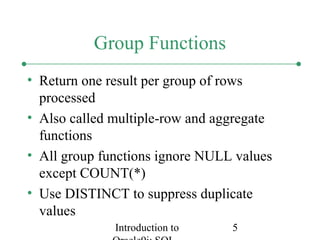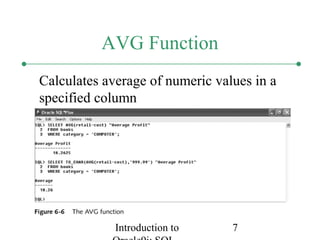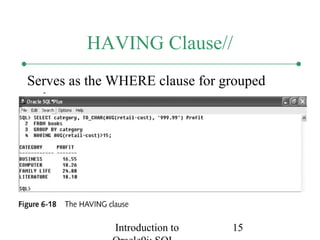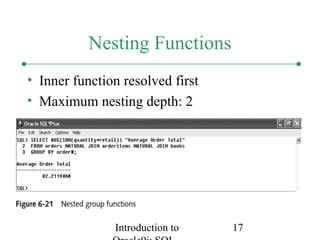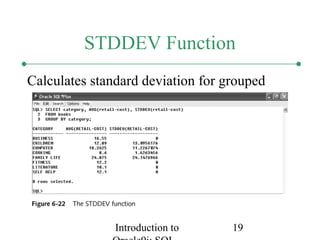Sql group functions(2)
- 1. Introduction to 1 SQL Group Functions
- 2. Introduction to 2 Chapter Objectives • Differentiate between single-row and multiple-row functions • Use the SUM and AVG functions for numeric calculations • Use the COUNT function to return the number of records containing non-NULL values • Use COUNT(*) to include records containing NULL values
- 3. Introduction to 3 Chapter Objectives • Use the MIN and MAX functions with non- numeric fields • Determine when to use the GROUP BY clause to group data • Identify when the HAVING clause should be used • List the order of precedence for evaluating WHERE, GROUP BY, and HAVING clauses
- 4. Introduction to 4 Chapter Objectives • State the maximum depth for nesting group functions • Nest a group function inside a single-row function • Calculate the standard deviation and variance of a set of data, using the STDDEV and VARIANCE functions
- 5. Introduction to 5 Group Functions • Return one result per group of rows processed • Also called multiple-row and aggregate functions • All group functions ignore NULL values except COUNT(*) • Use DISTINCT to suppress duplicate values
- 6. Introduction to 6 SUM Function Calculates total amount stored in a numeric column for a group of rows
- 7. Introduction to 7 AVG Function Calculates average of numeric values in a specified column
- 8. Introduction to 8 COUNT Function Two purposes: – Count non-NULL values – Count total records, including those with NULL values
- 9. Introduction to 9 COUNT Function – Non-NULL Values Include column name in argument to count number of occurrences
- 10. Introduction to 10 COUNT Function – NULL Values Include asterisk in argument to count number of rows
- 11. Introduction to 11 MAX Function Returns largest value
- 12. Introduction to 12 MIN Function Returns smallest value
- 13. Introduction to 13 GROUP BY Clause • Used to group data • Must be used for individual column in the SELECT clause with a group function • Cannot reference column alias
- 14. Introduction to 14 GROUP BY Example
- 15. Introduction to 15 HAVING Clause// Serves as the WHERE clause for grouped data
- 16. Introduction to 16 Order of Clause Evaluation When included in the same SELECT statement, evaluated in order of: – WHERE – GROUP BY – HAVING
- 17. Introduction to 17 Nesting Functions • Inner function resolved first • Maximum nesting depth: 2
- 18. Introduction to 18 Statistical Group Functions • Based on normal distribution • Includes: – STDDEV – VARIANCE
- 19. Introduction to 19 STDDEV Function Calculates standard deviation for grouped data
- 20. Introduction to 20 VARIANCE Function Determines data dispersion within a group





